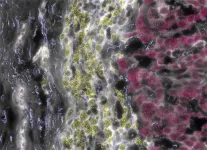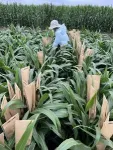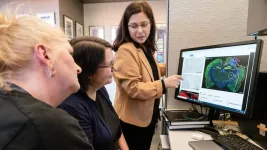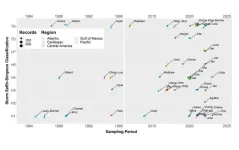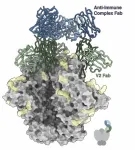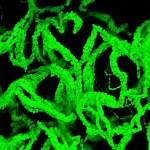(Press-News.org) Like many rare diseases, fibrolamellar hepatocellular carcinoma (FLC) mounts a ferocious attack against an unlucky few—in this case, children, adolescents, and young adults. Because its symptoms can vary from person to person, it’s often missed or misdiagnosed until it has metastasized and becomes lethal. Moreover, drug therapies for common liver cancers are not just useless for FLC patients but actually harmful.
But new insights about the disease, coupled with a just-launched clinical trial of a promising drug treatment, could significantly improve health outcomes. Researchers in Rockefeller University’s Laboratory of Cellular Biophysics, headed by Sanford M. Simon, has discovered that FLC has a distinct transcriptomic “signature”—a set of activated genes—that makes it unique among liver cancers.
“Identifying which molecular changes characterize FLC is an important step to understanding how it arises and evolves, which may reveal potential therapeutical targets,” says first author David Requena, a senior researcher in the lab. “Ideally, our findings will refine the detection of the disease, change the course of treatment, and increase patient survival rates.”
The findings, published in Nature Communications, come as Simon’s lab begins a clinical trial that pairs two drugs into one treatment that preliminary results indicate is highly effective against FLC.
A decade of insights
In 2014, Simon’s team—led in part by his own then-teenage daughter, Elana, who had been diagnosed with FLC a few years before—discovered that the disease was caused by the fusion of two genes, DNAJB1 and PRKACA, caused by a small deletion in chromosome 19.
The lab recently determined that what is important is not formation of the fusion, but that the formation results in an increase of the amount of PRKACA—the catalytic subunit of protein kinase A—that is made. That is the true origin of the disease. FLC tumor cells essentially have a molecular imbalance: too many catalytic PKA proteins and not enough of the inhibitory ones that normally tamp down the protein and lock it into place. Unfettered, overabundant PKA is free to wreak havoc across the cell.
For the current study, the researchers wanted to know if there is a common pathway of disease following the burst of PKA proteins. Some liver tumors are categorized as “FLC-like” but lack the fusion protein. Are they actually FLC? And since FLC is impervious to treatments that inhibit other liver cancers, what differentiates it from these other malignancies?
The signature
To find out, the researchers performed a massive analysis of multiomics sequencing data from 1,412 tumors caused by a variety of liver cancers. It was the largest such analysis to date, with 220 samples from FLC tumors—more than six times as many as have been included in any prior study.
In this way, the team determined the transcriptomic signature of each tumor, revealing which dysregulations are unique to specific tumor types and which are common to all. Single-cell analysis with spatial resolution further helped them to identify how each cell type in the tumor contributes to the overall transcriptome.
The result: FLC emerged as a distinct outlier. “We identified 301 genes that were expressed differently in FLC than they were in other tumors, which really underscores how unique it is among liver cancers,” Requena says. “Moreover, 35 of those were highly expressed only in FLC. These genes could be tested for diagnostic applications in the clinic.”
They also found that any change in DNA that increased the amount of catalytic subunit relative to its regulatory subunit produced the same changes in the transcriptome. Some patients, for example, had a fusion to PRKACA in the ductal cells of the liver, producing cholangiocarcinoma, or in the ductal cells of the pancreas, producing intraductal pancreatic oncolytic neoplasms (IOPNs). Even though these were different fusions to PRKACA and were identified in cells other than hepatocytes, where FLC is found, they produced the same changes in the transcriptome. And some patients were only missing the regulatory subunit but still had the same changes.
Recently, the Simon Lab also demonstrated that these diseases responded to therapeutics in the same way that FLC does.
“Thus, we suggest that the cancer perhaps should be defined not by its DNA change but by the change it produces in the net balance of protein activity in the cell,” says Simon, the Günter Blobel Professor at Rockefeller.
They also compared the tumor transcriptomes against those of normal tissue samples taken from the margins of tumors found in FLC patients. Surprisingly, one had the FLC signature. Upon closer re-examination of the tissue, they spotted fibrous spans typical of the disease and cells that had the fusion transcript of DNAJB1::PRKACA. Removal of the tumor hadn’t captured all FLC cells. Such hidden time bombs could result in new cancer growth.
“This finding really demonstrates the importance of a complete examination of the margins of the tumor,” says Simon.
A promising clinical trial
With these insights in hand, the researchers have just begun a clinical trial to test the pairing of two anti-cancer medications, DT2216 and irinotecan, that the lab’s earlier research, published in 2022, indicated are effective against FLC when used in combination. This is being supported by the Children’s Oncology Group and the Pediatric Early Phase Clinical Trials Network of the NIH.
In parallel, the Simon Lab is also developing alternative therapeutics, an effort supported by the Cancer Grand Challenge, a highly competitive initiative by Cancer Research (UK) and the National Cancer Institute (US) that offers $25 million grants over five years to consortiums of researchers working towards similar goals. Simon’s lab is part of the KOODAC team, in which different labs are attempting to degrade an oncoprotein—in Simon’s case, fusions with PRKACA—to prevent or kill tumors. Simon aims to present their findings at the annual meeting of the American Association for Cancer Research in late April.
“Ten years ago, it was our hope that by focusing on comprehensively characterizing a single, albeit rare, disease we could made rapid progress on developing both diagnostics and therapeutics that would not only advance FLC treatment but provide a roadmap for other diseases,” he says. “The recent findings from our group validate that hope and offer the promise that these insights can be translated not just to other cancers—such as Ewing sarcoma, rhabdomyosarcoma, and neuroblastoma—but also to illnesses in which we have to eliminate a protein that is not functioning properly.”
END
Unique characteristics of a rare liver cancer identified as clinical trial of new treatment begins
2025-01-17
ELSE PRESS RELEASES FROM THIS DATE:
From lab to field: CABBI pipeline delivers oil-rich sorghum
2025-01-17
Researchers at the Center for Advanced Bioenergy and Bioproducts Innovation (CABBI) have developed a new sorghum variant that can outperform soybeans in oil production, with great potential as a clean source of renewable fuel.
Scientists have long worked to create new sustainable sources of vegetable oils, known as triacylglycerols (TAG), to meet the growing demand for renewable fuels like sustainable aviation fuel (SAF) and renewable diesel.
Currently, oil palm and oilseeds such as soybeans provide most TAG for renewable ...
Stem cell therapy jumpstarts brain recovery after stroke
2025-01-17
SAN FRANCISCO—Every 40 seconds, someone in the United States has a stroke. For survivors of the most common type of stroke, called an ischemic stroke, only about 5 percent fully recover. Most others suffer from long-term problems, including weakness, chronic pain, or epilepsy.
Now, scientists at Gladstone Institutes and the regenerative medicine company SanBio have shown that a cell therapy derived from stem cells can restore normal patterns of brain activity after a stroke. While most stroke treatments must be administered in the immediate hours ...
Polymer editing can upcycle waste into higher-performance plastics
2025-01-17
Polymer editing can upcycle waste into higher-performance plastics
By editing the polymers of discarded plastics, chemists at the Department of Energy’s Oak Ridge National Laboratory have found a way to generate new macromolecules with more valuable properties than those of the starting material. Upcycling may help remedy the roughly 450 million tons of plastic discarded worldwide annually, of which only 9% gets recycled; the rest is incinerated or winds up in landfills, oceans or elsewhere.
ORNL’s ...
Research on past hurricanes aims to reduce future risk
2025-01-17
Tropical storms like hurricanes are not only terrifying, but also incredibly costly for coastal regions across the United States, Mexico, Central America and the Caribbean. Beyond the immediate devastation, these storms contribute to significant economic losses and human displacement. In 2023 alone, climate migration linked to such events saw 2.5 million individuals attempt to cross the U.S. southern land border.
New research led by The University of Texas at Arlington emphasizes that studying ...
UT Health San Antonio, UTSA researchers receive prestigious 2025 Hill Prizes for medicine and technology
2025-01-17
SAN ANTONIO, Jan. 17, 2025 – On the eve of a historic merger between The University of Texas Health Science Center at San Antonio and The University of Texas at San Antonio, researchers from the two institutions have been honored with highly prestigious 2025 Hill Prizes, in medicine and technology.
The prizes are awarded by the Texas Academy of Medicine, Engineering, Science and Technology (TAMEST), and Lyda Hill Philanthropies, which fund the awards to “propel high-risk, high-reward ideas and innovations that demonstrate very significant potential for real-world impact and can lead ...
Panorama of our nearest galactic neighbor unveils hundreds of millions of stars
2025-01-17
In the decades following the launch of NASA's Hubble Space Telescope, astronomers have tallied over 1 trillion galaxies in the universe. But only one galaxy stands out as the most important nearby stellar island to our Milky Way — the Andromeda Galaxy. It can be seen with the naked eye on clear autumn nights as a faint oval object roughly the size of the moon.
A century ago, astronomer Edwin Hubble first established that this so-called "spiral nebula" was approximately 2.5 million light years away from our own Milky Way galaxy.
Now, the space telescope named ...
A chain reaction: HIV vaccines can lead to antibodies against antibodies
2025-01-17
LA JOLLA, CA—Many vaccines work by introducing a protein to the body that resembles part of a virus. Ideally, the immune system will produce long-lasting antibodies recognizing that specific virus, thereby providing protection.
But Scripps Research scientists have now discovered that for some HIV vaccines, something else happens: after a few immunizations the immune system begins to produce antibodies against immune complexes already bound to the viral protein alone. They don’t yet know whether this chain reaction, described in Science ...
Bacteria in polymers form cables that grow into living gels
2025-01-17
Scientists at Caltech and Princeton University have discovered that bacterial cells growing in a solution of polymers, such as mucus, form long cables that buckle and twist on each other, building a kind of "living Jell-O."
The finding could be particularly important to the study and treatment of diseases such as cystic fibrosis, in which the mucus that lines the lungs becomes more concentrated, often causing bacterial infections that take hold in that mucus to become life threatening. This discovery ...
Rotavirus protein NSP4 manipulates gastrointestinal disease severity
2025-01-17
Researchers at Baylor College of Medicine and collaborating institutions have improved our understanding of how rotavirus, the most common cause of acute gastroenteritis in children, makes people sick. The study published in Science Advances is among the first to show that the rotavirus protein NSP4 is both necessary and sufficient for multiple aspects of rotavirus infection by disrupting calcium signaling not only within infected cells but also in nearby uninfected cells. These disruptions in calcium signaling affect rotavirus disease severity, providing new insights into how ...
‘Ding-dong:’ A study finds specific neurons with an immune doorbell
2025-01-17
Interleukin-1 (IL-1) is a key molecule involved in inflammation and plays an important role in both healthy and diseased states. In disease, high levels of IL-1 in the brain are linked to neuroinflammation, which can disrupt the body’s stress response, cause sickness-like behaviors, worsen inflammation by activating brain immune cells, and allow immune cells from the body to enter the brain. It also can lead to brain damage by causing support cells to produce harmful molecules. Elevated IL-1 levels are associated with mood disorders, ...
